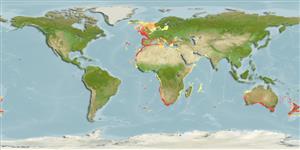>
Scombriformes (Mackerels) >
Trichiuridae (Cutlassfishes) > Lepidopodinae
Etymology: Lepidopus: Greek, lepis = scale + Greek, pous = foot (Ref. 45335).
Environment: milieu / climate zone / depth range / distribution range
Ecología
marino bentopelágico; oceanodromo (Ref. 51243); rango de profundidad 42 - 620 m (Ref. 56504), usually 100 - 300 m (Ref. 6181). Deep-water; 64°N - 49°S, 29°W - 176°W (Ref. 6181)
Eastern Atlantic: France and western Mediterranean to Senegal, including Azores, Madeira, the Canary Islands and offshore seamounts; Cape Fria, Namibia to Agulhas Bank, South Africa including northern Walvis Ridge. Southern Indian Ocean: seamounts 30 to 35°S. Southwest Pacific: Australia (New South Wales to southern West Australia) and New Zealand. Southeast Pacific: Peru. A doubtful record from Cape San Lucas, Mexico.
Length at first maturity / Tamaño / Peso / Age
Maturity: Lm 111.0, range 92 - ? cm
Max length : 210 cm TL macho / no sexado; (Ref. 36731); common length : 117 cm SL macho / no sexado; (Ref. 6181); peso máximo publicado: 8.0 kg (Ref. 6181); edad máxima reportada: 8 años (Ref. 117131)
Radios blandos dorsales (total): 98-110; Espinas anales 2; Radios blandos anales: 59 - 66; Vértebra: 105 - 114. Second anal-fin spine plate-like. Pyloric caeca 20 - 29. Body uniformly silvery (Ref. 6181). Pelvic fin very small (Ref. 35388).
Occur on continental shelf, along its edge and upper slope down to 400 m (600 m in Australia), usually over sandy and muddy bottoms from 100 to 250 m (over 300 m in Australia). Depth range from 333-620 m in the eastern Ionian Sea (Ref. 56504). Migrate into midwater at night. Form schools; occasionally found inshore in upwelling of deep water when it appears at surface. Feed on crustaceans, small squid and fish (Ref. 6768). Eggs and larvae are pelagic (Ref. 6768).
Nakamura, I. and N.V. Parin, 1993. FAO Species Catalogue. Vol. 15. Snake mackerels and cutlassfishes of the world (families Gempylidae and Trichiuridae). An annotated and illustrated catalogue of the snake mackerels, snoeks, escolars, gemfishes, sackfishes, domine, oilfish, cutlassfishes,. scabbardfishes, hairtails, and frostfishes known to date. FAO Fish. Synop. 125(15):136 p. (Ref. 6181)
IUCN Red List Status (Ref. 130435)
Threat to humans
Harmless
Human uses
Pesquerías: muy comercial; pesca deportiva: si
Más información
ColaboradoresImágenesStamps, Coins Misc.SonidosCiguateraVelocidadTipo de nataciónSuperficie branquialOtolitosCerebrosVisión
Herramientas
Special reports
Download XML
Fuentes de Internet
Estimates based on models
Preferred temperature (Ref.
123201): 9.8 - 16, mean 12.1 °C (based on 330 cells).
Phylogenetic diversity index (Ref.
82804): PD
50 = 0.5156 [Uniqueness, from 0.5 = low to 2.0 = high].
Bayesian length-weight: a=0.00041 (0.00032 - 0.00052), b=3.11 (3.04 - 3.18), in cm total length, based on LWR estimates for this species (Ref.
93245).
Nivel trófico (Ref.
69278): 3.8 ±0.3 se; based on diet studies.
Resiliencia (Ref.
120179): Medio, población duplicada en un tiempo mínimo de 1.4-4.4 años (K=0.14-0.38; tmax=5-8).
Prior r = 0.41, 95% CL = 0.27 - 0.61, Based on 4 stock assessments.
Fishing Vulnerability (Ref.
59153): Moderate to high vulnerability (53 of 100).
Climate Vulnerability (Ref.
125649): Moderate vulnerability (38 of 100).
Nutrients (Ref.
124155): Calcium = 12.7 [5.3, 26.3] mg/100g; Iron = 0.278 [0.126, 0.619] mg/100g; Protein = 17.3 [15.6, 19.0] %; Omega3 = 0.219 [0.095, 0.529] g/100g; Selenium = 34.6 [12.2, 93.0] μg/100g; VitaminA = 4.17 [0.63, 22.13] μg/100g; Zinc = 0.279 [0.173, 0.476] mg/100g (wet weight); based on
nutrient studies.
